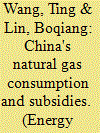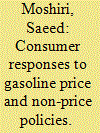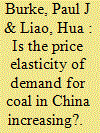| Srl | Item |
| 1 |
ID:
127279


|
|
|
|
|
| Publication |
2014.
|
| Summary/Abstract |
China's natural gas consumption is growing rapidly and it has being driven by economic growth, industrialization and urbanization. In addition, the country's low-carbon development strategy, government-controlled gas price, and some other factors also contribute to the surging gas consumption. This paper studies China's natural gas consumption in residential, industrial and commercial sectors. We adopt the cointegration test and error correction model to study the relationships of explanatory factors and gas consumption of different sectors and climate factor is included into the analysis. In order to find the direction of natural gas pricing reform and establish the benchmark gas price, this paper also estimates the size of gas price subsidy by using price-gap approach. Our findings are as follows: In the long term, China's residential sector is more sensitive to price than the other two. Urbanization is an important factor promoting industrial and commercial gas consumption. Prices of other energies have an influence on natural gas consumption significantly due to the substitutability between energies. The slow-moving and unsatisfying pricing reforms on refined oil and natural gas lead to positive price elasticity of natural gas in the commercial sector, which implies that a further energy price reform is still stringent for China.
|
|
|
|
|
|
|
|
|
|
|
|
|
|
|
|
| 2 |
ID:
171369


|
|
|
|
|
| Summary/Abstract |
Gasoline consumption in emerging economies have been rising rapidly due to economic growth and increasing urbanization rate in recent years. However, the development has brought about new socio-economic and environmental challenges leading governments to adopt various policies to control the trend. Although the impacts of price changes on gasoline consumption are well-researched in the literature, studies on different policies in a specific country is limited. In this paper, we investigate the impact of three distinct policies (price reform, rationing, and fuel-efficiency) on consumer responses in Iran. We estimate price, income, and efficiency elasticities across household characteristics, income groups, and provinces using the AIDS model and the household expenditures data for the period 2005–2016. The results show that the average price elasticity is -76, however, it varies across household characteristics, time, and space. The price responses are greater in provinces neighbouring the countries with high price differentials and welfare losses of price reform are more sever for lower income families. The estimated elasticities under different policy regimes show that energy price reform has led to significantly higher elasticities, while rationing has led to decreased elasticities. The more stringent efficiency regulation and increasing imports of fuel-efficient cars have also increased elasticities.
|
|
|
|
|
|
|
|
|
|
|
|
|
|
|
|
| 3 |
ID:
143377


|
|
|
|
|
| Summary/Abstract |
China's dependence on coal is a major contributor to local and global environmental problems. In this paper we estimate the price elasticity of demand for coal in China using a panel of province-level data for 1998–2012. We find that provincial coal demand has become increasingly price elastic. As of 2012 we estimate that this elasticity was in the range − 0.3 to − 0.7 in point estimate terms when responses over two years are considered. The results imply that China's coal market is becoming more suited to price-based approaches to reducing emissions. The elimination of coal consumption subsidies could reduce national coal use and related emissions by around 2%.
|
|
|
|
|
|
|
|
|
|
|
|
|
|
|
|
| 4 |
ID:
162898


|
|
|
|
|
| Summary/Abstract |
The political failure of China's first independent regulator in a strategic industry – the State Electricity Regulatory Commission (SERC), 2002–2013 – provides a natural experiment to uncover fundamental challenges to a gradualist approach to electricity market formation. Taking a political institutional approach, we show that while it was largely predictable that the breakup of the monopolistic power industry in 2002 created bureaucratic and corporate interests that would undercut the institutional role of SERC, subsequent difficulties in reforming electricity pricing, dispatch system, and integrating renewable energy sources strongly suggests that a central regulatory body would be necessary to lead a decisive transition to a market-based electricity market.
|
|
|
|
|
|
|
|
|
|
|
|
|
|
|
|